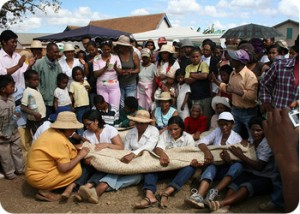 the Travel Enthusiast
the Travel Enthusiast
- 17 Jan
andra88 in Travel Planning | 2 COMMENTSCustoms and traditions: Famadihana ceremony in Madagascar
 When you go to a foreign place, sightseeing is sometimes not enough if you want to learn about the place’s culture, or how the people there live. Visiting during a festival or a celebration of any kind can bring out the best in any destination.
When you go to a foreign place, sightseeing is sometimes not enough if you want to learn about the place’s culture, or how the people there live. Visiting during a festival or a celebration of any kind can bring out the best in any destination.You’ll still be able to visit sights, but you’ll also have the backup option of participating to an important event in the lives of the inhabitants, and learning about their customs and traditions. And if you’re in Madagascar, you might want to take a peek to how Famadihana, one of the biggest festivals in the country, is celebrated.
About the ceremony
For the Western mind of the traveler, Famadihana is a downright gruesome event. Famadihana is also known as the turning of the bones, literally. The dead are taken out of the family crypts, wrapped in new shrouds, while people dance and listen to music.
These repeated ceremonies are the designed to help the spirit of the dead join the spirits of the ancestors in the otherworld, and the entire extended family of the deceased gathers from all over the country in order to help their kin. Famadihana is not an old festival in historical terms, and it dates back to around the 17th century (supposedly it evolved from other local funerary customs), but it is one of the most popular festivals in Madagascar.
Despite the fact that it is a festival of the dead, Famadihana is often anything but sad. The relatives of the deceased sing the favourite songs of the deceased, they dance and they feast. Although Famadihana occurs every 2 to 7 years only, Malagasy people save funds for year in order to afford a proper Famadihana for their dead loved ones.
- Flights
- Hotels
- Packages
- Cars
- Cruises
travel search by Travelgrove (get this widget)Preparations and celebration
One of the key elements in the festival is the silk shroud in which the corpse was buried. During Famadihana, the shroud must be changed, and it is customary that it is made of silk (which is why some Malagasy need to save up or quite a while in order to afford it).
When a person dies, the relatives and the friends of the grieving family offer money in order to help buy the lambamena, and wealthy relations might even offer it as a gift. The deceased is wrapped in all the shrouds he/she receives, and the number is an indicator of their popularity during their lifetimes.
When the festival begins, the dead are taken out of their tombs, and laid out in tents so that the family can start celebrating. The festivities can take up to days, and all the relatives who are not busy partying and dancing, help out with cooking for the guests.
The tent of a family can fill with hundreds of people: neighbors, friends, relatives. The celebration is lively and jolly until the moment of the shroud change, when the deceased has to be laid back to their resting place.
You might also like
Comments on Customs and traditions: Famadihana ceremony in Madagascar
Enter your comment below, or trackback from your own blog. You can also subscribe to these comments via RSS
erato wrote on February 1, 2013:I think everyone is quicker to notice the faults in their own culture as that is what one knows best, but for outsiders I am sure Madagascar culture is fascinating. Plus it might seem to be exaggeration, but I think there is nothing wrong with following old traditions, they have brought us to where we are now.
 Leave a comment:
Leave a comment:

I’m from Madagascar, and for me that culture is not bad , but the way we are doing sometimes is exaggerating.
I WOULD DO IT MORE SIMPLE, Thank you